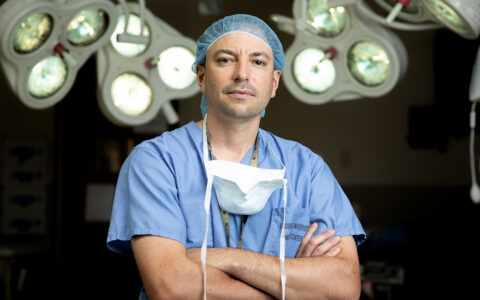André Churchwell, M.D., is chief diversity officer for Vanderbilt University Medical Center, senior associate dean for diversity affairs in the Vanderbilt University School of Medicine, and interim vice chancellor for Equity, Diversity and Inclusion at Vanderbilt University.
Churchwell and his team in the Department of Equity, Diversity and Inclusion, in partnership with Arie Nettles, Ph.D., director of the Office of Inclusion and Health Equity at the Monroe Carell Jr. Children’s Hospital at Vanderbilt, have developed a robust and multifaceted unconscious bias training program at Vanderbilt that has become a model for other academic medical centers. The Medical Center was just named among the 2019 Top Hospitals for Diversity by BlackDoctor.org.
Discoveries caught up with Churchwell following a recent faculty training series.
Evolution of Unconscious Bias Training
Discoveries: You’re a cardiologist, a biomedical engineer and a professor – and you’ve been involved in diversity issues for more than 30 years. When did the real interest in unconscious bias training in medicine begin?
Churchwell: It came out of the publication of a treatise in 2003 when we began to realize that there was unequal treatment of patients – especially based on income level, race and gender. And as a cardiologist, I saw firsthand that heart patients from underserved populations were not being given equal treatment in ERs or given the same treatments for coronary disease – fewer stents, less bypass surgery.
When we really began looking into it, we gasped! We all went into medicine to be caregivers and to deliver the highest level of evidence-based care; we were sitting around the table wondering how this happened. We didn’t believe doctors were inherently evil or racist, so we started looking at other factors. We knew there were key pre-hospital factors that determined your outcomes – the social determinants of health – but we didn’t see how that could tell the entire story.
We started thinking, “Maybe these health outcomes are not just based on something that’s going on in the community.” Work began in earnest and the data began to show that unconscious bias does exist in medicine. This was especially true for certain members of our Latino, African American, Native American, and other underserved populations.
Unconscious vs. Conscious Bias
Discoveries: How does unconscious bias differ from conscious bias?
Churchwell: Researchers suggest that unconscious bias occurs automatically as the brain makes quick judgments based on past experiences and background. What that boils down to is that for human beings to function and evolve on the Serengeti plains and to survive wars, there have been a lot of filters that have developed; if you see someone running at you with a machete, you run. This “automatic” thinking lets us process 40 things at any one moment to make a decision on one or two things. In contrast, deliberate prejudices are defined as conscious bias (or explicit bias).
Additionally, you inherently learn by practicing behaviors over and over. As a cardiologist, you don’t think about what to do when someone comes into the ER with cardiac arrest and undergoing CPR. In this case, automatic thinking allows us to act quickly and move on to the next thing.
But this kind of thinking is lousy for interpersonal interactions – especially in medicine. A lot of times, when we’re making hiring decisions, working with colleagues, or treating patients, these interpretations and past experiences come into play. We all have “blind spots” for certain people or cases we don’t recognize. Unconsciously, we think, “That person is from a group of people my parents don’t trust.”
Role of Training
Discoveries: How can training undo this unconscious bias in the medical setting?
Churchwell: We have come to realize that it’s a three-step process: awareness; education; mindfulness. First, you need to confront your own biases through examples. On the education side, we give people tools to shine a flashlight on everything they’re thinking as they’re talking to someone or reviewing a resume. For instance, we teach them to find positive examples of people whose lives are different from theirs and reflect on those: “This person reminds me of a guy my dad was good friends with from the service.”
Finally, you learn to slow down your thinking so that when you’re dealing with people, you use your “slow thinking” brain instead of the automatic brain. If you can get to the level of awareness that you have this problem, then you’ll be more present when you go into a situation.
“If you can get to the level of awareness that you have this problem, then you’ll be more present when you go into a situation.”
Top-Down Approach
Discoveries: What does that training look like at an academic medical center?
Churchwell: At Vanderbilt, we’ve been conducting unconscious bias training for several years. It really started four or five years ago when Dean Balser said that all chairs and deans had to go through the training (Jeffrey Balser, M.D., Ph.D., President and CEO, Vanderbilt University Medical Center; Dean, Vanderbilt University School of Medicine). Cook Ross, the consultants we hired to help us, came and led the all-day session. It was energizing, it was catalytic; it made everyone understand the power and value of why we needed to do this.
Today, all first-year med students are required to go through the training; all new staff have to go through it; as of this year, all new faculty have to go through it. We’re also using it for chair searches; search committees have to go through a little bit of extra training. At this point, we’ve trained about 5,000 of the 20,000 faculty, staff and trainees at the Medical Center.
We will never train everyone, but we’re counting on “herd immunity.” Our goal is to inoculate enough people so that when they’re in hiring committees or other groups they will speak up and call out inappropriate behavior or comments.
Variety of Training Options
Discoveries: What training models have you found to be successful?
Churchwell: We conduct several types of training sessions. Remember, we used day-long sessions to engage our most senior leadership. In addition, there are one-hour awareness sessions that every department is required to go through; two-hour sessions tailored for specific groups within the departments; longer sessions to train the trainers. We also provide tools and resources for self-training.
Training the trainers is critical; we must have certified trainers to make this work. This training is led by Dr. Nettles. In the first session, we trained 15 faculty, staff and HR leaders. Now “Arie’s Army” is up to almost 30 trainers.
Opportunities for Affinity
Discoveries: How does this translate to collaborative work?
Churchwell: One key thing we need for addressing our own unconscious biases is to have close interpersonal relationships with people who are different from us. At Vanderbilt, we’re creating opportunities for this in every corner, through special programs, community partnerships, committees, and affinity groups that bring people together from of different races, genders, religions, and other identities. Perhaps the best example of an affinity group is the Vanderbilt University Medical Center Choir.
The key is to get people together; give them a sense of belonging so they’re coming to work for something more than punching the clock. Between this and the training we’re trying to create a Vanderbilt character filter: when you walk through the portals you use wisdom, reverence, temperance, and empathy. This kind of training reaches into people, and hopefully, they’ll take it into their lives outside of work.
“This kind of training reaches into people, and hopefully, they’ll take it into their lives outside of work.”
Impact on Diversity
Discoveries: So how are these programs and groups impacting diversity at the Medical Center?
Churchwell: You can see palpable, living examples of how this is playing out in the Vanderbilt culture. Some of our new department chairs are Latino and African American. Recently, as I’ve been digging into our databases, I’ve found out that the national representation of all chairs of medical schools is seven percent from underrepresented groups; at Vanderbilt, we’re at seventeen percent.
On the Diversity Liaison Committee, one or two people from each department who are passionate about this issue join like-minded folks from other departments. That group is developing best practices to take diversity inclusion principles back to the departments. Our hope is that the departments will develop their own affinity groups.
In 2018, AAMC requested that all participating members present their best cases involving diversity and inclusion. Seven of our posters were chosen out of 30 submitted by 150 medical schools. Dr. Nettles has helped create a national network of children’s hospitals to address unconscious bias. That group has published a data collection framework for identifying disparities.
Implementing a Program
Discoveries: Do you have advice for others who wish to implement a program like this?
Churchwell: What you’ll find is that every organization is different, and the program has to be tailored – even by department. And it must evolve to incorporate what’s happening in the culture at large. It takes work, this kind of stuff. But it’s well worth the effort!





